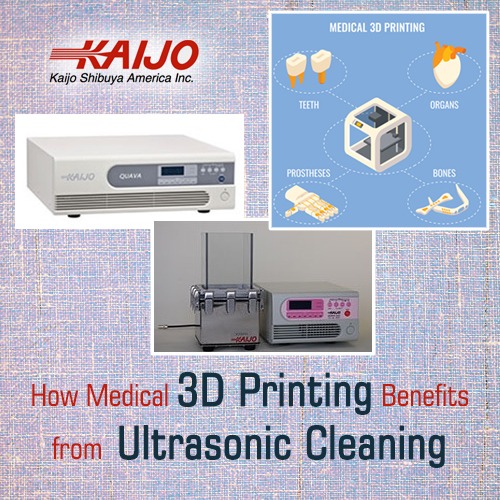Medical 3D Printing Benefits from Ultrasonic Cleaning
February 16, 2018
 Hospitals, medical research centers and facilities are increasingly using industrial ultrasonic cleaners on 3D printed models of organs or body parts to create prosthetics. Organ models for a particular patient can help determine the best way to proceed with surgery and may help with accurate diagnosis. Both models and prosthetics are used in educational programs as well. When used in such programs and in medical practice or research, the 3D printed product gives a complete reproduction that can be examined from all sides rather than a flat image showing only one side.
Hospitals, medical research centers and facilities are increasingly using industrial ultrasonic cleaners on 3D printed models of organs or body parts to create prosthetics. Organ models for a particular patient can help determine the best way to proceed with surgery and may help with accurate diagnosis. Both models and prosthetics are used in educational programs as well. When used in such programs and in medical practice or research, the 3D printed product gives a complete reproduction that can be examined from all sides rather than a flat image showing only one side.
Organs and body parts often have complex shapes and irregular surfaces that must be reproduced in the 3D printing process. To accurately create intricate protrusions and make sure the model does not collapse when holes and crevices are printed, the 3D printing process deposits support material as well as the material used to build the model. The support material temporarily holds up the build material until the latter has hardened and is self supporting. The support material then has to be removed. To ensure model accuracy, it is important to remove the support material cleanly and completely.
How Ultrasonic Cleaning Removes Support Material
Ultrasonic cleaning can remove the support material without affecting the build material and can ensure that the removal is rapid and complete. Depending on the materials used, the ultrasonic cleaning system can operate at frequencies delivering exactly the right cleaning strength.
The industrial ultrasonic cleaning systems consist of an ultrasonic generator, a transducer and a cleaning tank. The generator produces the ultrasonic electrical signal and the transducer converts the electrical impulses into ultrasonic waves in the cleaning solution. Microscopic cavitation bubbles are created in the pressure troughs of these waves and the bubbles collapse in the pressure peaks. When the bubbles come into contact with the support material, the scrubbing action of the bubbles removes the material while the build material is left unaffected.
Low frequencies can be used for build materials that can withstand a strong cleaning action and for robust models. Frequencies of 26kHz or 38kHz produce large bubbles and a strong cleaning action. Delicate models or models with fragile build materials can have the support material removed with higher frequencies delivering gentle cleaning action. Frequencies up to the megahertz range produce smaller bubbles and the resulting cleaning action is gentler. Ultrasonic cleaning system manufacturers can help design systems that deliver just the right amount of cleaning strength for the 3D printing materials used.
The Advantages of Using Industrial Ultrasonic Cleaners
Ultrasonic cleaning systems are ideal for removing medical 3D printed support material because they provide several advantages over traditional methods using harsh chemicals to dissolve the material. Such advantages include the following:
- Cleaning is rapid and completely removes the support material while leaving the build material unaffected.
- The ultrasonic cleaning process is completely safe for the personnel preparing the models.
- No toxic chemicals are introduced into the medical environment.
- Disposal of the wastewater does not require additional safety procedures.
Kaijo has a complete line of industrial ultrasonic cleaning systems and equipment with the latest technology and the advanced features required for medical 3D printing. The company can supply compact and self-contained turnkey systems or separate components to be assembled in a custom solution. Kaijo has extensive experience in ultrasonic cleaning and personnel with the expertise to select the systems, frequencies and power ideal for specific medical 3D printing applications. Kaijo’s industrial ultrasonic cleaners are being used at medical facilities to remove 3D printing support material and can help ensure that such applications meet the needs of the medical profession.





